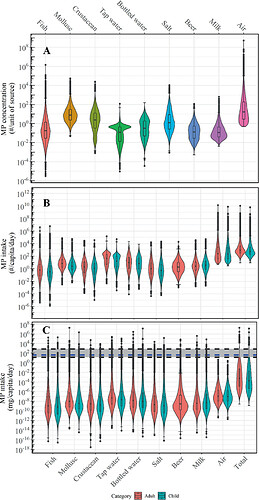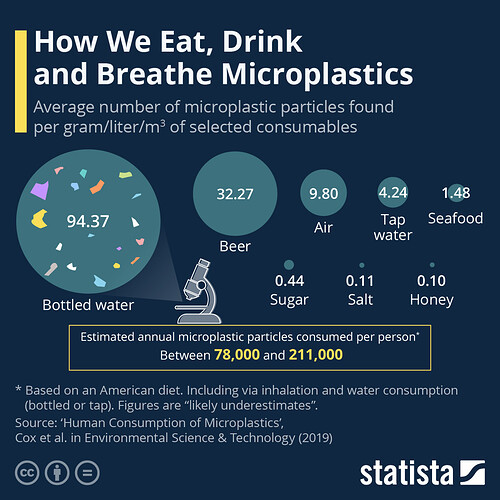Microplastics (these nasty entropy-increasing substances) have a way of making it into anything - they even have a way of making it into fruits/vegetables and human placenta (and are found in the blood of most humans - Microplastics found in human blood for first time | Plastics | The Guardian ). Concentrations in the environment may only increase over time, given explosive increases in plastic use + breakdown. That they increase over time means that we should get more concerned over time (=past publications systematically underestimate their risk). These particles may be expected to only bioaccumulate, given that the cell is not great at getting rid of them (membrane penetration is unknown, but more likely for smaller less quantifiable nanoplastics).
Microplastics are a much bigger concern in long-lived humans than short-lived model organisms - this is b/c humans have way more time to accumulate them in their lifetimes.
While you cannot eliminate microplastics, you can still reduce them by a factor of 50-80%, which is “good enough” for a lot of “risk reduction” (similarly with reducing PM2.5 air pollution from 20 to 8 - it’s “not enough”, but it’s “enough” for the most risk reduction). Eric Topol notes that the differences observed seen in the human population are already enough to be significant for disease.
If you have ever heard of sick building syndrome or multiple chemical sensitivity, microplastics may be part of the culprit. I am personally way more concerned about the irregular plastic particles than I am about the more noticeable phthalates/BPA b/c it’s unclear if the cell can ever get rid of them. Microplastics can get into the brain - it is unknown to what extent they hurt energy/intelligence/adaptability/clarity of one’s thinking, but the accumulated hit definitely worsens over time.
Carbon nanotubes stress and disrupt the cell’s external structure - microplastics follow a distribution of size vs volume and the smaller microplastics might be similar to air pollution and nanoparticles in how smaller sizes are more easily absorbed by the cell (OR the cell nucleus) and more likely to disrupt the cell structure. The neurological effects of them (The plastic brain: neurotoxicity of micro- and nanoplastics | Particle and Fibre Toxicology | Full Text) may be the most worrisome effects of all.
There may be more microplastics in the soil than the ocean.. Source 2. Farmlands in Europe may be the single largest reservoir of microplastics in the world
https://www.sciencedirect.com/science/article/pii/S0160412022001258
Microplastics have been found in all human organs: Microplastic particles now discoverable in human organs | Plastics | The Guardian (important to figure out how many particles per gram - one liver cirrhosis study showed 0-2 particles per gram of normal tissue, and ~6-8 in those with liver cirrhosis). These are likely underestimates given (a) increases in plastic pollution over time, (b) detection methods are still immature, so there is bias in reporting only the larger microplastics.
Despite these limitations and the often observed absence of a clear dose-dependence of the effects (in particular for gene expression studies), there seem to be several consistent effects. Several studies reported the accumulation of micro- and nanoplastics in brain tissue of fish and indications that micro- and nanoplastics can cross the blood-brain barrier [22, 79, 80, 86]. This is confirmed by additional literature observing blood-brain barrier permeability for polystyrene nanoparticles in vivo [110] and internalization in neuronal cells in vitro [97, 98, 111, 112]. Overall, these findings highlight that (human) exposure to micro- and nanoplastics can result in systemic uptake and/or accumulation in the brain.
Some 80-20 tips on reducing microplastic exposure:
The easiest way to reduce microplastics is appetite suppression via semaglutide/tirzepatide. Both to reduce food consumption/control when you’re hungry, and to reduce situations where you get so hungry that you end up eating from plastic-wrapped food.
Bring paper bags with you to the grocery store to put fruits/veggies in. Fruits fit in really well - veggies might be a bit harder, but there are paper bags of different shapes you can try. Whole foods has small paper bags you can put fruit in [harder for veggies…]
STAY AWAY FROM STYROFOAM/POLYSTYRENE/Polyvinyl chloride. The health effects of other microplastics are still being debated, but we know for sure that polystyrene/PC are VERY bad.
Pouring hot water (like that used for coffee/tea) into “paper cups” releases trillions of nanoplastics (https://www.nist.gov/news-events/news/2022/04/nist-study-shows-everyday-plastic-products-release-trillions-microscopic ). This is a 2022 NIST study that uses better analytical techniques than most prior microplastics studies (calculations of microplastic load, esp in the 2019 meta-review, are all underestimates, b/c they undercount the smallest most damaging/permeative kinds of plastics). Moreover, nanoplastics can get through the blood brain barrier.. Steel coffee percolators (or french press) is the way to prepare coffee (and loose-leaf tea) with minimal hot-water-on-plastic load.
Plastic tea bags can release billions of microplastics. Even standard teabags are 20-30% plastic (use loose-leaf tea or take the tea out of the bag before brewing it [and even then, the tea is most likely contaminated with some microplastics]). https://www.science.org/content/article/your-tea-could-contain-billions-plastic-particles?utm_label=AAAS%23ScienceMagArchives&utm_medium=twitter&utm_source=social&utm_campaign=AAAS
(bring a lightweight biocomposite mug with you on your pack in case you want to get coffee/tea when outside)
Especially STAY AWAY FROM bottled water (https://interestingengineering.com/bottled-water-drinkers-could-consume-up-to-640000-microplastics-a-year), get an air purifier, wear N95/N99 masks when convenient/possible (as a sig. fraction of air pollution is from plastics, esp plastics from car tires), wear cotton/lint clothing (plastics from clothing can accidentally get on your hands=>mouth), wash food that has been inside plastic containers, especially stay away from styrofoam (polystyrene is unique in its toxicity), use aggressive water filters like SimplyFiltered (though filters, even reverse osmosis ones, often use plastics). Stay away from food packaged in plastic containers for long periods of time (esp when in contact with water for a long time) - the amount of microplastics that leech into food from storage containers can only increase over time - it may be better to remove food from the package and immediately pour into a non-plastic container for storage.
Fruits have higher microplastic loads than vegetables.- Microplastics are contaminating the fruit and vegetables we eat including apples and lettuces | Daily Mail Online (this 2020 study was measured through a patented method that counts 195,000 particles per GRAM of apple which is way higher than any other prior estimate). All pre-2024 measurements of microplastics are severe underestimates b/c they don’t count nanoplastics. Based on speculation from this one small study (there will be more info in the future ), plants with shallow root structures (eg green leafy vegetables/legumes) on average have less microplastic contamination from ones with deeper root structures (eg root vegetables or fruits/nuts that grow on trees). Leafy greens seem safest (esp b/c they are also most keto). They are also easiest to grow using your own microplastic-free soil. Soil is way more contaminated with MPs than the oceans.
Pay attention to where food is grown (esp away from high human population densities) - especially to whether or not the crops are watered with water close to wastewater/sewage. Most sewage is not yet filtered for microplastics, but scientists at Bayreuth have developed a simple method. Avoid sea salt (Himalayan rock salt healthier)
GIVEN that it now seems that ALL food has microplastics in it, even fruits/vegetables, it may be wiser to reduce the total volume of food one eats (nicotine gum/stimulants [like coffee/tea] help a lot, as does semaglutide, as does drinking LOTS of microplasticfiltered water), and possibly even to increase the calorie energy density so that one eats less food in total (eg increase % calories from purified extra-virgin olive oil). Perhaps going keto is the best way to reduce microplastics, esp b/c keto reduces appetite and forces you to not eat fruit.
Or just grow your own food using your own soil
https://www.sciencedirect.com/science/article/pii/S2352186422000724
food takeout containers: https://www.sciencedirect.com/science/article/abs/pii/S0304389420309584
Lab-grown cultured salmon (https://www.wildtypefoods.com/) is advertised as being microplastic free (more control over the process). Presumably this means hydroponics should be safer from microplastics once they actually start caring…
The EU (especially France) is way more progressive than the US on plastics. https://www.fastcompany.com/3063976/france-is-banning-plastic-forks-causing-the-disposable-junk-industry-to-panic . When I visited, I noticed many more foods stored in glass containers, as well as disposable utensils that were all made of wood. England Is Banning Some Single-Use Plastics. Activists Say It’s a Small Step. - The New York Times
AVOID GETTING INTO SITUATIONS THAT GET YOU INTO NEEDING BLOOD/PLASMA TRANSFUSIONS. (basically the direct analogy to directly injecting plastic into your veins) They often use bags full of polyvinyl chloride, the worst.
In the past (before 2015), some have said that certain plastics are safer than others (eg they advise you to look at the packaging and stay away from plastics labeled type 3, 4, or 5). This was done before microplastics became their own research field (based on suspicions about endocrine disruptors and the notable cytotoxicity of styrene). Now it appears that microplastics of all kinds can bioaccumulate in the cell - even the more inert kinds that were previously considered benign (polyethylene or polypropylene), and it may be better for us to avoid all sources of plastic exposure altogether. Shape of plastic may matter more than composition.
Human body burdens of microplastics through table salt, drinking water, and inhalation were estimated to be (0–7.3)×10^4, (0–4.7)×10^3, and (0–3.0)×10^7 items per person per year, respectively [underestimate]
Sturdier plastics leach less than “flexible” plastics (this is why plastic water bottles are so uniquely bad). “Rougher” plastics are more damaging.
As for canned food - even bisphenol-A-free containers may have resin that has been contaminated by BPS or polyvinyl or even polystyrene.
It’s clear that canned food has largely moved away from BPA, but what are they using in new can linings? That part is less clear. The new linings are made from either acrylic, polyester, non-BPA epoxies, polyvinyl chloride (PVC) copolymers, or olefin polymers. Which one depends on the manufacturer. A 2016 report by several nonprofit groups Buyer Beware: Toxic BPA and regrettable substitutes in the linings of canned food notes that many of these new linings are not great alternatives. PVC is not a great substitute because it’s made from vinyl chloride, a known carcinogen. And many of the acrylic linings include polystyrene (hello styrofoam!), which is also a possible human carcinogen. Adequate testing to ensure that these new linings are safe for food have not been done. And it’s probably no surprise that neither PVC or polystyrene are great for the environment!
Even some of the newest liners, like olefin polymers, which are partially derived from plants, have not been completely studied for safety, many times because their formulation is not publicly available.
PFAS might not be a microplastic, but have detrimental effects and you should stay away from them by not using oral-glide-B floss. They may also be found in water pollution so look up water pollution tables of your state.
Furniture and carpets are a major source (so hard to avoid). Wood floors are better, also run air purifiers near overly fibrous furniture
Some brands of almond milk may have an inner coating in tetrapaks made of polyethylene based microplastics) - try to pick almond milk that isn’t packaged in tetrapaks (whole foods almond milk isn’t, for instance)
Strength training helps b/c it helps you carry more food in glass/cans/non-plastic bags (and not rely as much on grocery delivery)
Much microplastic exposure from the air: https://pubs.acs.org/doi/10.1021/acs.est.9b04535 (this is before more recent studies counted up more microplastics in food - keep in mind that the number will only go higher in the nanoplastic levels, and the smaller particle sizes are more damaging)
Estimating total lifetime microplastic exposure: Estimating lifetime microplastic exposure | ScienceDaily (2021 ACS study, likely an underestimate)
for flexible packaging - maybe use silicones (Silicone ) - eg stasher bags
""Widely used plasticizers with endocrine disrupting properties, e.g. dibutyl phthalate, dimethyl phthalate, butyl benzyl phthalate, or plastic monomers such as Bisphenol A (BPA), can affect both development and reproduction in marine species: effect concentrations of plasticizers in laboratory experiments in some sensitive species such as molluscs, crustaceans and amphibians (including disturbance in spermatogenesis in fish) coincide with measured environmental concentrations in the low nanogram/litre to microgram/litre range. It should be remarked that there are still basic knowledge gaps, including the long-term exposures to environmentally relevant concentrations and their ecotoxicity when part of complex mixtures [61]. Other EDCs, such as alkylphenols, have the capacity to derail male reproductive development leading to feminisation or demasculinization of the male form in fish and altered sex in molluscs. Others, such as tin-containing plastic stabilisers, elicit immunological disorders in fishes and induce imposex in gastropods [71].""
Areas of microplastic research: analytical chemistry of microplastics, microplastic quantification and trendlines (eg https://www.nature.com/articles/s41467-020-17932-9 )
From a 2019 study (https://pubs.acs.org/doi/10.1021/acs.est.0c07384 ) [these numbers are likely to be underestimates, and were way lower than the fruit/vegetable MP study]
Potato chip bags are really bad - https://www.nature.com/articles/s41598-020-61146-4
(this paper uses mass loss as a way to estimate microplastic load, but does not report on where the mass loss is [eg opening a bottle cap releases microplastics but I’d expect most of the released MPs to go outside rather than inside the food packaging])
microplastics in our daily lives was monitored during the tearing open of chocolate bags (~300 cm), cutting of sealing tapes (~300 cm), and twist-opening of plastic bottle-caps (~40 bottles), as shown in Fig. 3.
Our work shows that opening plastic packages can generate microplastics in daily life, regardless of the opening approach and plastic target, although the opening approach affects the amount of microplastics generated. These processes can generate a mass change in the range of 10–30 nanograms (Figs. 1/3/S4, via QCM, to collect ~0.05% of the microplastics, discussed below). That is, approximate 14,000–75,000 microplastics (for a 300 cm forward length) are generated, given 0.8–1.4 nanogram per microplastic in mass
Go for brands that use wax packaging rather than plastic packaging (eg Monetzuma’s chocolate)…
Fund/people to go into environmental engineering of alternatives! (like silk as an alternative!) Vegan Spider Silk | Spider Silk Uses
a side addendum: it’s possible that plant-based waxes/cellulose/tannins (esp the most indigestible plant foods) can also get “stuck in cells/impossible to lodge out” to the pt that they also disrupt cell communication (tho I’m still way more concerned about microplastics).
LONG-TERM ENGINEERING SOLUTIONS
(note, PETE is way easier to break down than polyethylene or polypropylene b/c it requires fewer steps and the inter-polymer bonds are way more distinct than inter-polymer bonds of normal biological tissue)
More water filter links:


